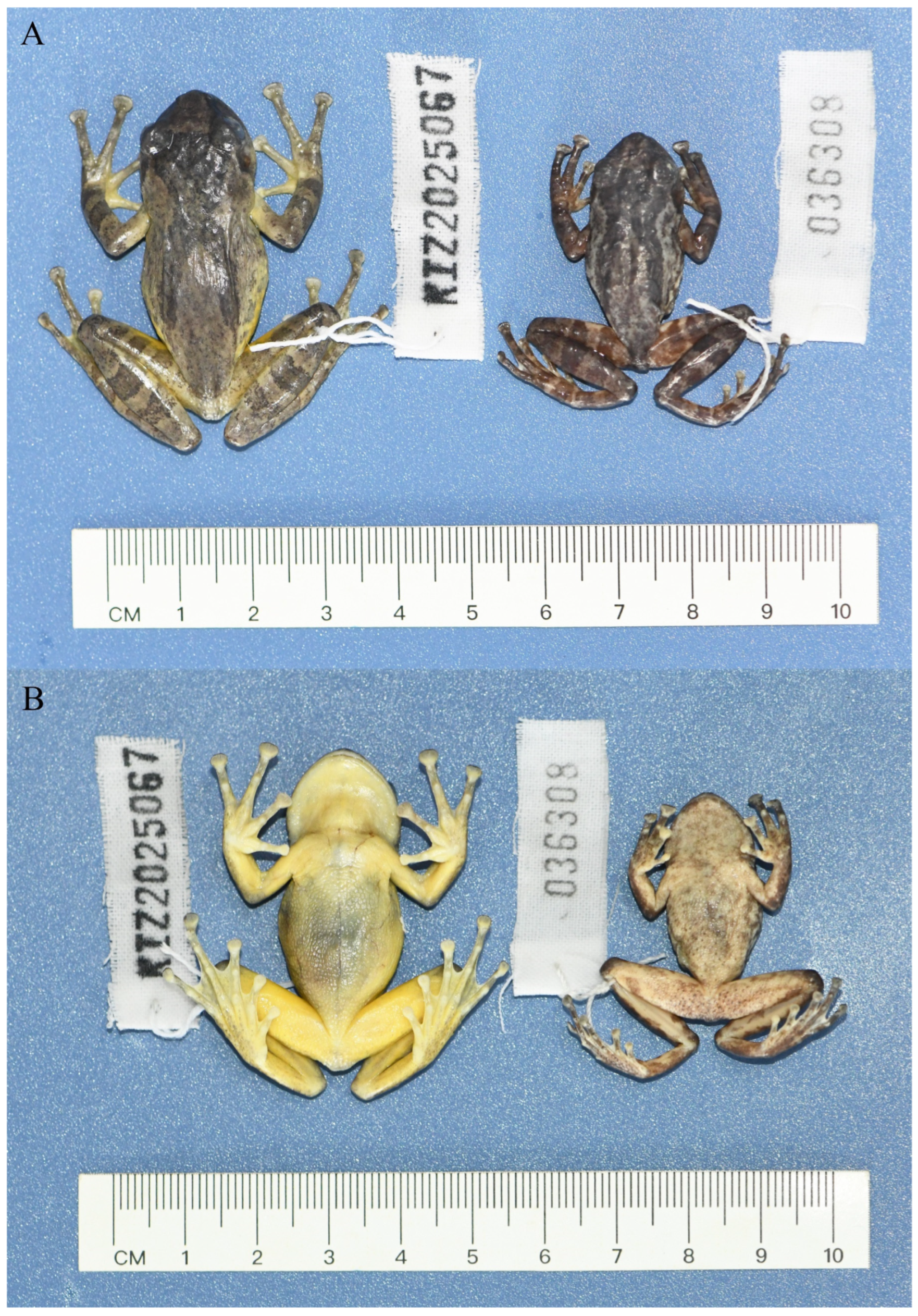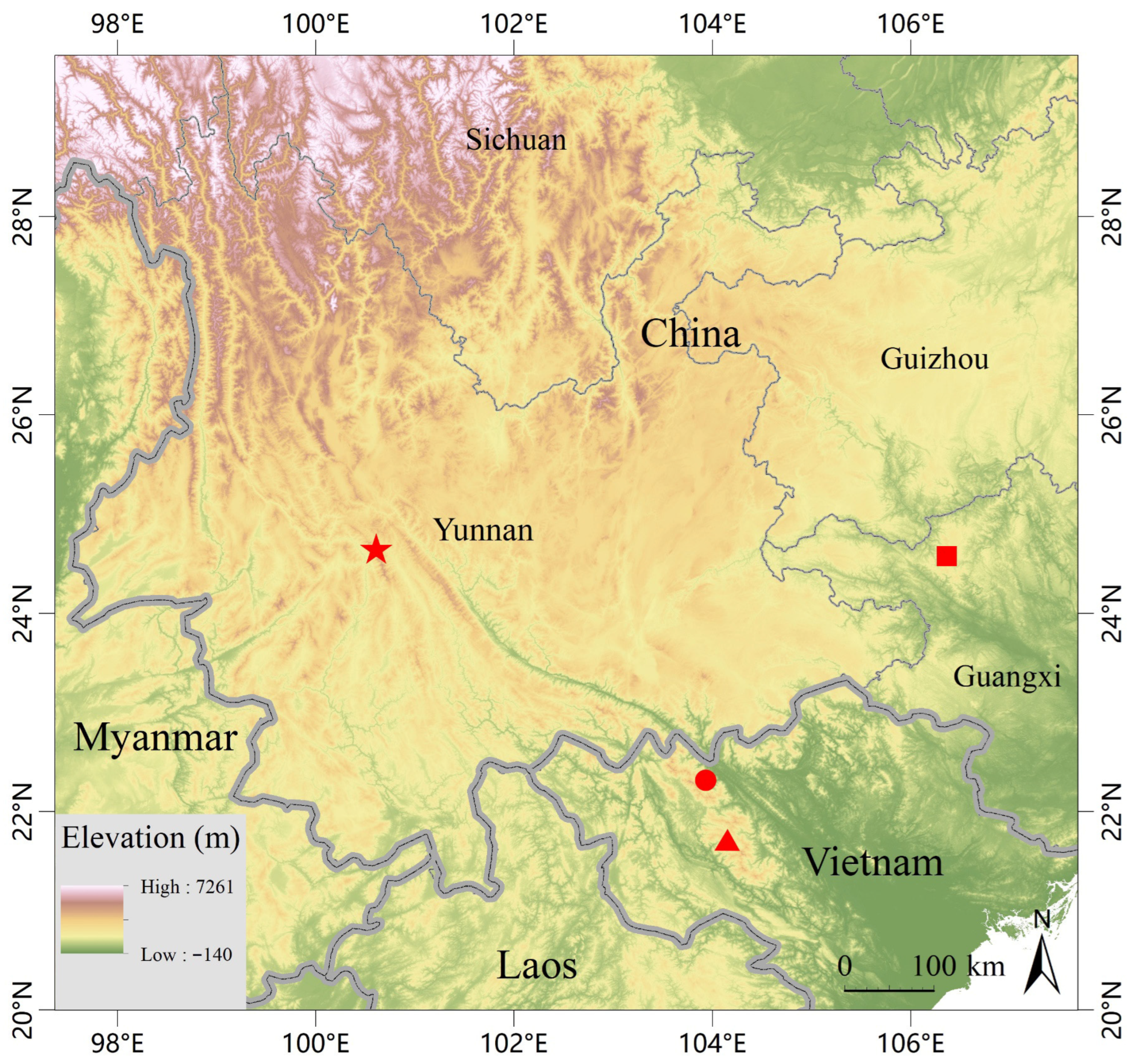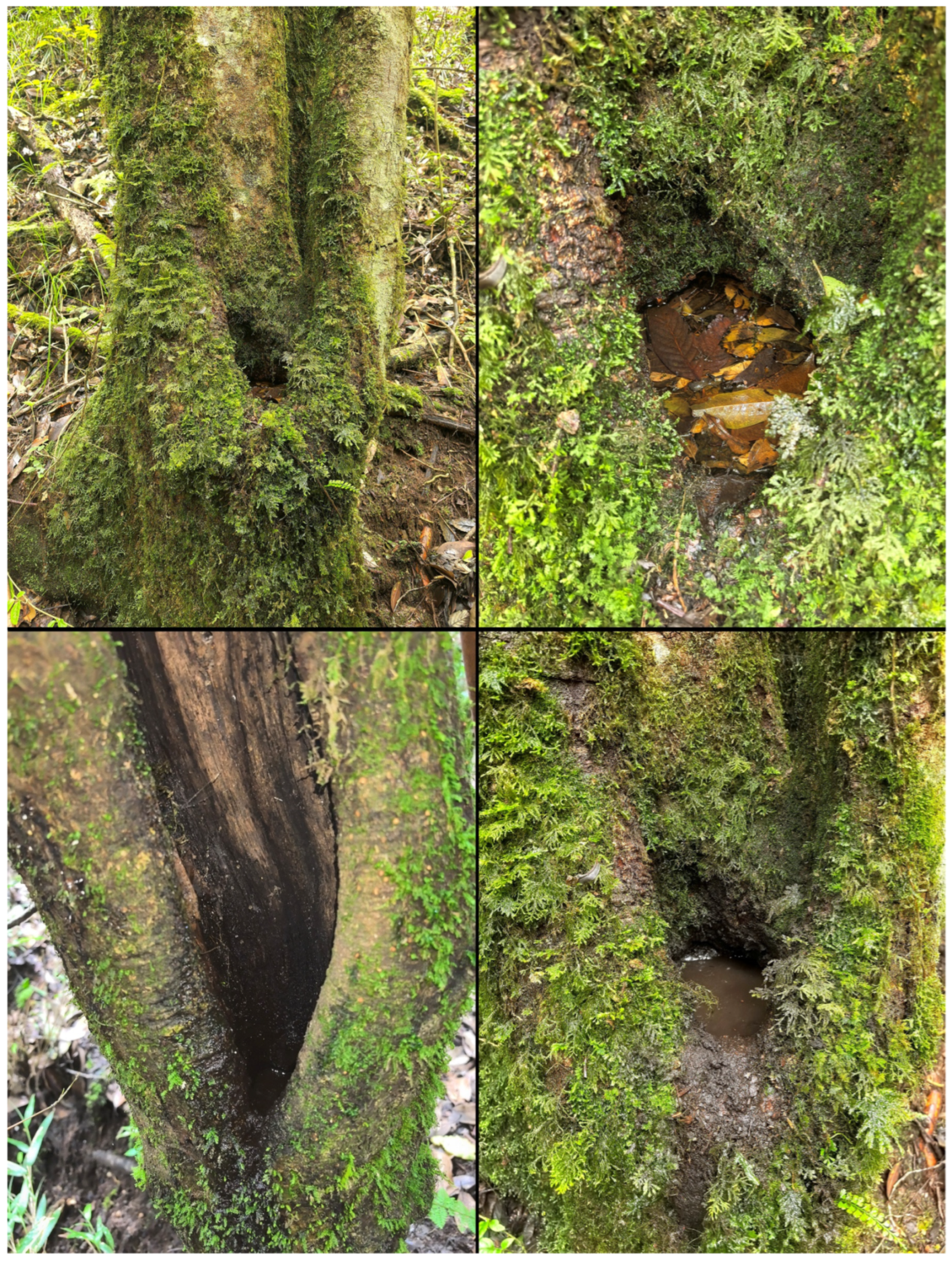A New Species of the Genus Gracixalus (Anura, Rhacophoridae) from Central Western Yunnan, China †
Abstract
1. Introduction
2. Materials and Methods
3. Results
3.1. Phylogenetic Relationship
3.2. Taxonomic Account
3.3. Etymology
3.4. Diagnosis
3.5. Description of Holotype
3.6. Coloration of Holotype in Life
3.7. Coloration of Holotype in Preservative
3.8. Variations
3.9. Distribution
3.10. Natural History Notes
3.11. Comparisons
4. Discussion
Author Contributions
Funding
Data Availability Statement
Acknowledgments
Conflicts of Interest
References
- Fei, L. Atlas of Amphibians of China; Henan Press of Science and Technology: Zhengzhou, China, 1999. [Google Scholar]
- Boruah, B.; Deepak, V.; Patel, N.G.; Jithin, V.; Yomcha, T.; Das, A. A new species of green tree frog of the genus Gracixalus (Anura, Rhacophoridae) from the evergreen forest of Northeast India. Vertebr. Zool. 2023, 73, 557–574. [Google Scholar] [CrossRef]
- Wang, J.; Zeng, Z.C.; Lyu, Z.T.; Liu, Z.Y.; Wang, Y.Y. Description of a new species of Gracixalus (Amphibia, Anura, Rhacophoridae) from Guangdong Province, southeastern China. Zootaxa 2018, 4420, 251–269. [Google Scholar] [CrossRef]
- Luo, J.Q.; Zhang, B.A.; Pan, Y.Q.; Yu, G.H. A new species of Gracixalus (Anura, Rhacophoridae) from Guangxi, China, with comments on the taxonomy of Orixalus. Zoosyst. Evol. 2025, 101, 369–388. [Google Scholar] [CrossRef]
- Frost, D.R. Amphibian Species of the World: An Online Reference. Version 6.2.; American Museum of Natural History: New York, NY, USA, 2025; Available online: https://amphibiansoftheworld.amnh.org/index.php (accessed on 25 August 2025).
- Amphibia Web. Information on Amphibian Biology and Conservation; University of California: Berkeley, CA, USA, 2025; Available online: http://amphibiaweb.org/ (accessed on 25 August 2025).
- Amphibia China. The Database of Chinese Amphibians; Kunming Institute of Zoology (CAS): Kunming, China, 2025; Available online: http://www.amphibiachina.org/ (accessed on 25 August 2025).
- Liu, J.; Peng, C.C.; Wang, B.; Feng, C.B.; Shen, T.; Li, S.Z.; Chen, J.J.; Su, H.J.; Tang, X.J. A new species of Gracixalus (Amphibia, Anura, Rhacophoridae) from Guizhou Province, China. Zoosyst. Evol. 2025, 101, 405–417. [Google Scholar] [CrossRef]
- Wu, X.J.; Pa, Y.Q.; Chen, J.; Ye, J.P.; Yu, G.H.; Zou, T.X. Integrative taxonomic evidence for a new species of genus Gracixalus (Anura, Rhacophoridae) from Mao’er Mountain, Guangxi, China. Zoosyst. Evol. 2025, 101, 2039–2053. [Google Scholar] [CrossRef]
- Delorme, M.; Dubois, A.; Grosjean, S.; Ohler, A. Une nouvelle classification générique et subgénérique de la tribu des Philautini (Amphibia, Anura, Rhacophorinae). Bull. Mens. Soc. Linn. Lyon 2005, 74, 165–171. [Google Scholar] [CrossRef]
- Li, J.T.; Che, J.; Bain, R.H.; Zhao, E.M.; Zhang, Y.P. Molecular phylogeny of Rhacophoridae (Anura): A framework of taxonomic reassignment of species within the genera Aquixalus, Chiromantis, Rhacophorus, and Philautus. Mol. Phylogenet. Evol. 2008, 48, 302–312. [Google Scholar] [CrossRef]
- Dubois, A.; Ohler, A.; Pyron, R.A. New concepts and methods for phylogenetic taxonomy and nomenclature in zoology, exemplified by a new ranked cladonomy of recent amphibians (Lissamphibia). Megataxa 2021, 5, 1–738. [Google Scholar] [CrossRef]
- Mahony, S.; Kamei, R.G.; Brown, R.M.; Chan, K.O. Unnecessary splitting of genus-level clades reduces taxonomic stability in amphibians. Vertebr. Zool. 2024, 74, 249–277. [Google Scholar] [CrossRef]
- Tran, T.T.; Pham, A.V.; Le, M.D.; Nguyen, N.H.; Ziegler, T.; Pham, C.T. A new species of Gracixalus (Anura, Rhacophoridae) from northwestern Vietnam. ZooKeys 2023, 1153, 15–35. [Google Scholar] [CrossRef] [PubMed]
- Ge, M.; Liu, J.; Qi, J. National Park Double Boundary Delimitation: A Synergy-Based Approach Integrating Biodiversity and Ecosystem Services—An Example of Proposed Ailaoshan–Wuliangshan National Parks in China. Forests 2024, 15, 2159. [Google Scholar] [CrossRef]
- Yu, Q.; Cao, S.; Qian, D.; Gu, X. Wuliangshan National Nature Reserve; Yunnan Science and Technology Press: Kunming, China, 2004. [Google Scholar]
- Matsui, M.; Shimada, T.; Liu, W.Z.; Maryati, M.; Khonsue, W.; Orlov, N.L. Phylogenetic relationships of Oriental torrent frogs in the genus Amolops and its allies (Amphibia, Anura, Ranidae). Mol. Phylogenet. Evol. 2006, 38, 659–666. [Google Scholar] [CrossRef] [PubMed]
- Hedges, S.B. Molecular Evidence for the Origin of Birds. Proc. Natl. Acad. Sci. USA 1994, 91, 2621–2624. [Google Scholar] [CrossRef]
- Thompson, J.D.; Higgins, D.G.; Gibson, T.J. CLUSTAL W: Improving the sensitivity of progressive multiple sequence alignment through sequence weighting, position-specific gap penalties and weight matrix choice. Nucleic Acids Res. 1994, 22, 4673–4680. [Google Scholar] [CrossRef] [PubMed]
- Tamura, K.; Stecher, G.; Kumar, S. MEGA11: Molecular Evolutionary Genetics Analysis Version 11. Mol. Biol. Evol. 2021, 38, 3022–3027. [Google Scholar] [CrossRef]
- Kalyaanamoorthy, S.; Minh, B.Q.; Wong, T.K.; Von Haeseler, A.; Jermiin, L.S. ModelFinder: Fast Model Selection for Accurate Phylogenetic Estimates. Nat. Methods 2017, 14, 587–589. [Google Scholar] [CrossRef] [PubMed]
- Ronquist, F.; Huelsenbeck, J.P. MrBayes 3: Bayesian phylogenetic inference under mixed models. Bioinformatics 2003, 19, 1572–1574. [Google Scholar] [CrossRef]
- Nguyen, L.T.; Schmidt, H.A.; von Haeseler, A.; Minh, B.Q. IQ-TREE: A fast and effective stochastic algorithm for estimating maximum-likelihood phylogenies. Mol. Biol. Evol. 2015, 32, 268–274. [Google Scholar] [CrossRef]
- Matsui, M.; Ohler, A.; Eto, K.; Nguyen, T.T. Distinction of Gracixalus carinensis from Vietnam and Myanmar, with description of a new species. Alytes 2017, 33, 25–37. [Google Scholar]
- Le, D.T.; Do, Y.T.; Tran, T.T.; Nguyen, T.Q.; Orlov, N.L.; Ninh, T.H.; Nguyen, T.T. A new species of Gracixalus (Anura, Rhacophoridae) from Northern Vietnam. Russ. J. Herpetol. 2021, 28, 111–122. [Google Scholar] [CrossRef]
- Rowley, J.J.L.; Dau, Q.V.; Nguyen, T.T.; Cao, T.T.; Nguyen, S.N. A new species of Gracixalus (Anura, Rhacophoridae) with a hyperextended vocal repertoire from Vietnam. Zootaxa 2011, 3125, 22–38. [Google Scholar] [CrossRef]
- Nguyen, T.Q.; Le, M.D.; Pham, C.T.; Nguyen, T.T.; Bonkowski, M.; Ziegler, T. A new species of Gracixalus (Amphibia: Anura: Rhacophoridae) from northern Vietnam. Org. Divers. Evol. 2013, 13, 203–214. [Google Scholar] [CrossRef]
- Bain, R.H.; Nguyen, Q.T. Herpetofaunal diversity of Ha Giang Province in Northeastern Vietnam, with descriptions of two new species. Am. Mus. Novit. 2004, 3453, 1–42. [Google Scholar] [CrossRef]
- Orlov, N.L.; Ho, T.C.; Nguyen, Q.T. A new species of the genus Philautus from central Vietnam (Anura, Rhacophoridae). Russ. J. Herpetol. 2004, 11, 51–64. [Google Scholar]
- Fei, L.; Hu, S.Q.; Ye, C.Y.; Tian, W.S.; Jiang, J.P.; Wu, G.F.; Li, J.; Wang, Y.S. Fauna Sinica: Amphibia; Science Press: Beijing, China, 2009; Volume 2: Anura. [Google Scholar]
- Pham, C.T.; Rauhaus, A.; Tran, T.D.; Niggemann, C.; Dang, P.H.; Le, M.D.; Nguyen, T.Q.; Ziegler, T.; Rowley, D.; Nguyen, C. First record of Gracixalus quangi Rowley, Dau, Nguyen, Cao & Nguyen, 2011, from Hoa Binh Province, Vietnam, including the first documentation of advanced larval stages and an extended tadpole description. Amphib. Reptile Conse. 2019, 13, 90–103. [Google Scholar]
- Rowley, J.J.L.; Le, D.T.T.; Dau, V.Q.; Hoang, H.D.; Cao, T.T. A striking new species of phytotelm-breeding tree frog (Anura, Rhacophoridae) from central Vietnam. Zootaxa 2014, 3785, 25–37. [Google Scholar] [CrossRef]
- Rowley, J.J.L.; Le, D.T.T.; Hoang, H.D.; Cao, T.T.; Dau, Q.V. A new species of phytotelm breeding frog (Anura, Rhacophoridae) from the Central Highlands of Vietnam. Zootaxa 2020, 4779, 341–354. [Google Scholar] [CrossRef] [PubMed]
- Rowley, J.J.L.; Dau, Q.V.; Hoang, H.D.; Nguyen, T.T.; Le, D.T.T.; Altig, R. The breeding biologies of three species of treefrogs with hyperextended vocal repertoires (Gracixalus; Anura: Rhacophoridae). Amphib.-Reptil. 2015, 36, 277–285. [Google Scholar] [CrossRef]
- Zeng, Z.C.; Zhao, J.; Chen, C.Q.; Chen, G.L.; Zhang, Z.; Wang, Y.Y. A new species of the genus Gracixalus (Amphibia, Anura, Rhacophoridae) from Mount Jinggang, southeastern China. Zootaxa 2017, 4250, 171–185. [Google Scholar] [CrossRef] [PubMed]
- Chen, W.C.; Bei, Y.J.; Liao, X.W.; Zhou, S.C.; Mo, Y.M. A new species of Gracixalus (Anura, Rhacophoridae) from West Guangxi, China. Asian Herpetol. Res. 2018, 9, 74–84. [Google Scholar] [CrossRef]





| Species | Locality | Voucher no. | GenBank no. |
|---|---|---|---|
| Gracixalus wuliangshan sp. nov. | Jingdong, Yunnan, China | KIZ2025067 | PX600316 |
| Gracixalus wuliangshan sp. nov. | Jingdong, Yunnan, China | KIZ 036308 | PX600317 |
| Gracixalus ananjevae | Nghe An, Vietnam | VNMN 03012 | JN862546 |
| Gracixalus gracilipes | Lao Cai, Vietnam | AMS R 177672 | KT374014 |
| Gracixalus guangdongensis | Hunan, China | CIB HN201108200 | LC011936 |
| Gracixalus guangdongensis | Guangdong, China | SYS a005750 | MG520197 |
| Gracixalus huaping | Huaping, Guangxi, China | GXNU YU000480 | PP083976 |
| Gracixalus huaping | Huaping, Guangxi, China | GXNU YU000511 | PP083977 |
| Gracixalus jinggangensis | Jinggangshan, Jiangxi, China | SYS a003186 | KY624587 |
| Gracixalus jinggangensis | Jinggangshan, Jiangxi, China | SYS a003170 | KY624586 |
| Gracixalus jinxiuensis | Jinxiu, Guangxi, China | SYS a002183 | KY624585 |
| Gracixalus jinxiuensis | Jinxiu, Guangxi, China | SYS a002182 | KY624584 |
| Gracixalus liusanjieae | Guilin, Guangxi, China | GXNU YU000796 | PV746480 |
| Gracixalus liusanjieae | Guilin, Guangxi, China | GXNU YU000962 | PV746481 |
| Gracixalus lumarius | Kon Tum, Vietnam | AMS R 176202 | KF918412 |
| Gracixalus medogensis | Medog, Xizang, China | KIZ 010956 | MW023606 |
| Gracixalus nonggangensis | Longzhou, Guangxi, China | NHMG20091009 | JX841319 |
| Gracixalus nonggangensis | Longzhou, Guangxi, China | NHMG200910010 | JX841320 |
| Gracixalus patkaiensis | Northeast India | WII-ADA1352 | OQ940026 |
| Gracixalus quangi | Nghe An, Vietnam | AMS R173417 | JN862539 |
| Gracixalus quyeti | Cha Noi, Vietnam | VNUH 160706 | EU871428 |
| Gracixalus sapaensis | Lao Cai, Vietnam | ROM 39660 | GQ285670 |
| Gracixalus sapaensis | Lao Cai, Vietnam | KUHE 46401 | LC011938 |
| Gracixalus seesom | Kanchanaburi, Thailand | KUHE 35084 | LC011932 |
| Gracixalus supercornutus | Kon Tum, Vietnam | AMS R173887 | JN862545 |
| Gracixalus tianlinensis | Tianlin, Guangxi, China | NHMG 1705016 | MH117961 |
| Gracixalus tianlinensis | Tianlin, Guangxi, China | NHMG 1705015 | MH117960 |
| Gracixalus trieng | Kon Tum, Vietnam | AMS R176206 | MT328246 |
| Gracixalus trieng | Kon Tum, Vietnam | UNS 00342/AMS R176205 | MT328245 |
| Gracixalus truongi | Tuan Giao, Dien Bien, Vietnam | IEBR A.5006 | OP750514 |
| Gracixalus truongi | Tuan Giao, Dien Bien, Vietnam | IEBR A.5005 | OP750513 |
| Gracixalus weii | Leigongshan, Guizhou, China | MT LS20240518009 | PP852212 |
| Gracixalus weii | Leigongshan, Guizhou, China | MT LS20240518010 | PP852213 |
| Gracixalus yunnanensis | Menghai, Yunnan, China | KIZ 20160216 | MK234877 |
| Gracixalus yunnanensis | Lancang, Yunnan, China | KIZ 20160222 | MK234878 |
| Gracixalus ziegleri | Yen Bai, Vietnam | MCC.2018.35 | LC642813 |
| Gracixalus ziegleri | Yen Bai, Vietnam | MCC.2018.15 | LC642812 |
| Gracixalus sp. | Wenshan, Yunnan, China | 03320Rao | GQ285669 |
| Kurixalus idiootocus | Taiwan, China | KUHE 12979 | AB933306 |
| 1 | 2 | 3 | 4 | 5 | 6 | 7 | 8 | 9 | 10 | 11 | 12 | 13 | 14 | 15 | 16 | 17 | 18 | 19 | 20 | 21 | 22 | 23 | |
|---|---|---|---|---|---|---|---|---|---|---|---|---|---|---|---|---|---|---|---|---|---|---|---|
| 1 Gracixalus wuliangshan sp. nov. | |||||||||||||||||||||||
| 2 Gracixalus ananjevae | 5.6 | ||||||||||||||||||||||
| 3 Gracixalus gracilipes | 10.6 | 10.8 | |||||||||||||||||||||
| 4 Gracixalus guangdongensis | 4.5 | 4.4 | 9.7 | ||||||||||||||||||||
| 5 Gracixalus huaping | 6.7 | 7.4 | 10.1 | 5.8 | |||||||||||||||||||
| 6 Gracixalus jinggangensis | 5.8 | 7.3 | 10.3 | 5.4 | 6.3 | ||||||||||||||||||
| 7 Gracixalus jinxiuensis | 6.9 | 7.1 | 10.5 | 5.5 | 2.9 | 6.9 | |||||||||||||||||
| 8 Gracixalus liusanjieae | 5.5 | 7.0 | 9.4 | 4.1 | 3.9 | 5.2 | 3.1 | ||||||||||||||||
| 9 Gracixalus lumarius | 14.3 | 13.5 | 13.0 | 13.9 | 15.0 | 14.3 | 15.9 | 13.9 | |||||||||||||||
| 10 Gracixalus medogensis | 9.4 | 10.7 | 12.1 | 10.5 | 11.0 | 10.0 | 10.6 | 10.7 | 16.1 | ||||||||||||||
| 11 Gracixalus nonggangensis | 6.8 | 7.6 | 12.4 | 6.2 | 9.1 | 7.1 | 8.1 | 7.8 | 15.5 | 10.5 | |||||||||||||
| 12 Gracixalus patkaiensis | 10.6 | 10.6 | 3.8 | 8.9 | 9.2 | 9.9 | 9.6 | 8.6 | 13.1 | 12.1 | 11.7 | ||||||||||||
| 13 Gracixalus quangi | 9.3 | 9.7 | 4.8 | 8.1 | 8.8 | 7.6 | 9.5 | 8.2 | 12.8 | 11.9 | 11.0 | 3.8 | |||||||||||
| 14 Gracixalus quyeti | 10.8 | 11.3 | 7.2 | 10.0 | 10.0 | 11.3 | 10.3 | 9.3 | 13.5 | 12.5 | 12.3 | 7.2 | 5.9 | ||||||||||
| 15 Gracixalus sapaensis | 2.5 | 6.4 | 10.4 | 5.1 | 6.6 | 6.2 | 6.8 | 5.2 | 15.5 | 9.8 | 7.7 | 10.2 | 9.2 | 10.9 | |||||||||
| 16 Gracixalus seesom | 8.7 | 10.4 | 6.2 | 8.3 | 8.8 | 9.4 | 9.2 | 7.4 | 15.5 | 10.8 | 9.9 | 5.3 | 6.0 | 8.8 | 8.2 | ||||||||
| 17 Gracixalus supercornutus | 10.9 | 11.0 | 6.4 | 9.2 | 10.3 | 9.0 | 10.7 | 9.9 | 14.1 | 12.1 | 12.1 | 5.5 | 2.7 | 6.0 | 10.7 | 7.2 | |||||||
| 18 Gracixalus tianlinensis | 2.3 | 6.3 | 10.5 | 4.6 | 6.2 | 6.5 | 5.8 | 4.9 | 14.7 | 10.1 | 7.0 | 9.4 | 9.7 | 10.4 | 3.3 | 7.4 | 11.1 | ||||||
| 19 Gracixalus trieng | 3.5 | 5.3 | 10.1 | 3.5 | 5.7 | 5.0 | 5.2 | 4.2 | 13.7 | 9.1 | 6.6 | 9.0 | 8.2 | 8.8 | 4.6 | 7.4 | 9.4 | 4.0 | |||||
| 20 Gracixalus truongi | 6.1 | 6.2 | 11.0 | 5.0 | 6.7 | 6.5 | 7.5 | 6.3 | 14.8 | 10.8 | 8.2 | 9.7 | 8.8 | 10.7 | 6.6 | 9.9 | 9.7 | 5.8 | 4.5 | ||||
| 21 Gracixalus weii | 4.9 | 5.5 | 8.3 | 3.6 | 3.3 | 6.0 | 3.3 | 1.8 | 13.8 | 11.5 | 5.9 | 10.1 | 7.9 | 9.7 | 4.6 | 7.8 | 9.3 | 3.8 | 4.0 | 6.1 | |||
| 22 Gracixalus yunnanensis | 4.2 | 4.0 | 10.5 | 2.1 | 6.0 | 5.0 | 5.8 | 4.9 | 13.7 | 9.7 | 6.6 | 9.7 | 8.6 | 10.2 | 5.0 | 8.5 | 9.4 | 4.3 | 4.0 | 4.7 | 4.0 | ||
| 23 Gracixalus ziegleri | 2.4 | 5.3 | 10.5 | 4.5 | 5.8 | 5.7 | 6.1 | 5.2 | 14.9 | 9.6 | 6.9 | 11.0 | 9.7 | 11.2 | 3.1 | 8.1 | 10.9 | 2.4 | 3.7 | 5.4 | 4.1 | 4.0 | |
| 24 Gracixalus sp. | 9.0 | 2.3 | 11.6 | 5.3 | 7.9 | 7.7 | 7.3 | 6.5 | 14.0 | 10.7 | 8.5 | 11.6 | 10.1 | 11.0 | 8.4 | 9.7 | 10.8 | 6.5 | 5.1 | 6.7 | 5.7 | 5.0 | 9.7 |
| KIZ2025067 Female | KIZ 036308 Male | KIZ2025067 Female | KIZ 036308 Male | ||
|---|---|---|---|---|---|
| SVL | 44.1 | 31.9 | DPE | 13.6 | 10.7 |
| HL | 14.9 | 11.5 | MN | 12.3 | 9.5 |
| HW | 16.0 | 12.6 | FLL | 31.1 | 22.9 |
| SNL | 6.7 | 5.0 | LAL | 24.7 | 18.3 |
| IN | 4.3 | 3.7 | 3FD | 3.0 | 2.4 |
| IOD | 4.4 | 3.4 | HLL | 69.1 | 51.7 |
| ED | 5.0 | 4.1 | TL | 22.9 | 17.3 |
| UEW | 3.6 | 3.1 | TW | 5.7 | 4.3 |
| NEL | 3.5 | 2.7 | TFL | 33.1 | 24.3 |
| TD | 2.3 | 2.2 | FL | 22.8 | 16.4 |
| TEL | 1.2 | 0.8 | 3TD | 2.2 | 1.6 |
| DAE | 8.3 | 6.8 | IMT | 2.3 | 1.4 |
Disclaimer/Publisher’s Note: The statements, opinions and data contained in all publications are solely those of the individual author(s) and contributor(s) and not of MDPI and/or the editor(s). MDPI and/or the editor(s) disclaim responsibility for any injury to people or property resulting from any ideas, methods, instructions or products referred to in the content. |
© 2025 by the authors. Licensee MDPI, Basel, Switzerland. This article is an open access article distributed under the terms and conditions of the Creative Commons Attribution (CC BY) license (https://creativecommons.org/licenses/by/4.0/).
Share and Cite
Liu, S.; Yang, Z.; Wang, C.; Li, N.; Hou, M.; Luo, Z.; Rao, D. A New Species of the Genus Gracixalus (Anura, Rhacophoridae) from Central Western Yunnan, China. Taxonomy 2025, 5, 66. https://doi.org/10.3390/taxonomy5040066
Liu S, Yang Z, Wang C, Li N, Hou M, Luo Z, Rao D. A New Species of the Genus Gracixalus (Anura, Rhacophoridae) from Central Western Yunnan, China. Taxonomy. 2025; 5(4):66. https://doi.org/10.3390/taxonomy5040066
Chicago/Turabian StyleLiu, Shuo, Zhongfu Yang, Chunhua Wang, Nengping Li, Mian Hou, Zengyang Luo, and Dingqi Rao. 2025. "A New Species of the Genus Gracixalus (Anura, Rhacophoridae) from Central Western Yunnan, China" Taxonomy 5, no. 4: 66. https://doi.org/10.3390/taxonomy5040066
APA StyleLiu, S., Yang, Z., Wang, C., Li, N., Hou, M., Luo, Z., & Rao, D. (2025). A New Species of the Genus Gracixalus (Anura, Rhacophoridae) from Central Western Yunnan, China. Taxonomy, 5(4), 66. https://doi.org/10.3390/taxonomy5040066







